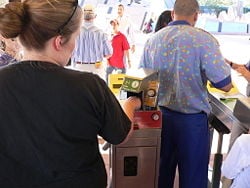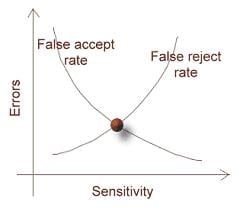Biometrics
- For the use of statistics in biology, see Biostatistics.
Biometrics is the the study of automated methods for uniquely recognizing humans based upon one or more intrinsic physical or behavioral traits. The term is derived from the Greek words "bios" for life and "metron" for measure.
In Information Technology (IT), biometric authentication refers to technologies for measuring and analyzing human physical and behavioral characteristics for authentication purposes. Examples of mostly physical characteristics include fingerprints, eye retinas and irises, facial patterns and hand measurements, while examples of mostly behavioural characteristics include signature, gait and typing patterns. Voice is considered a mix of both physical and behavioral characteristics, but all biometric traits share physical and behavioral aspects.
History
While biometrics did not show up in practice in Western cultures until late in the 19th century, it was being used in China by at least the 14th century. An explorer and writer by the name of Joao de Barros wrote that Chinese merchants stamped children’s palm prints and footprints on paper with ink. The merchants did this as a way to distinguish young children from one another.
In the West, identification relied heavily upon simply “photographic memory” until a French police desk clerk and anthropologist by the name of Alphonse Bertillon developed the anthropometric system (later also known as Bertillonage) in 1883. This was the first precise, scientific system widely used to identify criminals and it turned biometrics into a field of study. It worked by precisely measuring certain lengths and widths of the head and body, as well as recording individual markings such as tattoos and scars. Bertillon’s system was widely adopted in the West until the system’s flaws became apparent – mainly problems with differing methods of measurement and changing measurements. After that, Western police forces turned to fingerprinting – essentially the same system seen in China hundreds of years prior.
In recent years biometrics has moved from simply fingerprinting, to many different methods using various physical and behavioural measurements. The uses of biometrics have also increased – from just identification to security systems and more.
Operation and performance
In a typical IT biometric system, a person registers with the system when one or more of his physical and behavorial characteristics are obtained, processed by a numerical algorithm, and entered into a database. Ideally, when he logs in, nearly all of his features match; then when someone else tries to log in, she does not fully match, so the system will not allow her to log in. Current technologies have widely varying Equal Error Rates - as low as 60% and as high as 99.9%.
Performance of a biometric measure is usually referred to in terms of the false accept rate (FAR), the false nonmatch or reject rate (FRR), and the failure to enroll rate (FTE or FER).
In real-world biometric systems the FAR and FRR can typically be traded off against each other by changing some parameter. One of the most common measures of real-world biometric systems is the rate at the setting at which both accept and reject errors are equal: the equal error rate (EER), also known as the cross-over error rate (CER). The lower the EER or CER, the more accurate the system is considered to be.
Claimed error rates sometimes involve idiosyncratic or subjective elements. For example, one biometrics vendor set the acceptance threshold high, to minimize false accepts; in the trial, three attempts were allowed, and so a false reject was counted only if all three attempts failed. Another example: when measuring performance biometrics (e.g. writing, speech etc.), opinions may differ on what constitutes a false reject. If I train a signature verification system using my initial and surname, can I legitimately claim a false reject when it then rejects my first name and surname?
Despite these misgivings, biometric systems have the potential to identify individuals with a very high degree of certainty. Forensic DNA evidence enjoys a particularly high degree of public trust at present (ca. 2004) and substantial claims are being made in respect of iris recognition technology, which has the capacity to discriminate between individuals with identical DNA.
Issues and concerns
As with many interesting and powerful developments of technology, excessive concern with the biometric may have the effect of eclipsing a more general critical faculty. Biometrics may become associated with severe miscarriages of justice if bedazzlement with the performance of the technology blinds us to the following possibilities, where an individual could:
- plant DNA at the scene of the crime
- associate another's identity with his biometrics, thereby impersonating without arousing suspicion
- fool a fingerprint detector by using a piece of sticky tape with an authentic fingerprint on it
- fool an iris recognition camera by showing a photo of anothers iris
- interfere with the interface between a biometric device and the host system, so that a "fail" message gets converted to a "pass".
Identity theft
Identity theft concerns about biometrics use have not been resolved. If a person's credit card number is stolen, for example, it can cause them great difficulty. If their iris scan is stolen, though, and it allows someone else to access personal information or financial accounts, the damage could be irreversible. Often, biometric technologies have been rolled out without adequate safeguards for personal information gathered about individuals.
Privacy
Though biometrics often are touted as a way to restrict criminality, privacy advocates fear biometrics may be used to diminish personal liberties of law abiding citizens as well.
Developments in digital video, infrared, x-ray, wireless, global positioning satellite systems, biometrics, image scanning, voice recognition, DNA, and brain wave fingerprinting provide government with new ways to "search" individuals and collect vast databases of information on law-abiding members of the public.
Framers of the U.S. Constitution never thought about these kinds of "searches" when drafting the Fourth Amendment, but as technology advances, we have to think about them now.
Sociological concerns
As technology advances, and time goes on, more and more private companies and public utilities will use biometrics for safe, accurate identification. However, these advances will raise many concerns throughout society, where many may not be educated on the methods. Here are some examples of concerns society has with biometrics:
- Physical- Some believe this technology can cause physical harm to an individual using the methods, or that instruments used are unsanitary. For example, there are questions whether retina scanners are clean.
- Personal Information- There are concerns whether our personal information taken through biometric methods can be misused, tampered with or sold, e.g. by criminals stealing, rearranging or copying the biometric data. Also, the data obtained using biometrics can be used in unauthorized ways without the individuals consent.
Society fears in using biometrics will continue over time. As the public becomes more educated on the practices, and the methods are being more widely used, these concerns will become more and more evident.
This technology is being used at border crossings that have electronic readers that are able to read the chip in the cards and verify the information present in the card and on the passport. This method allows for the increase in efficiency and accuracy of identifying people at the border crossing. CANPASS, by Canada Customs is currently being used by some major airports that have kiosks set up to take digital pictures of a person’s eye as a means of identification.
Uses and initiatives
Brazil
Since the begining of 20th. century, Brazilian citzens use ID cards. Brazilian government choice for fingerprint was headed by Dr. Felix Pacheco at Rio de Janeiro, at that time capital of the Federative Republic. Dr. Felix Pacheco was friend of Dr. Juan Vucetich which invented one of the most complete tenprint classification system existing. The Vucetich system was adopted in Brazil and by most of the South American countries. The oldest and most traditional ID Institute in Brasil (Institute Felix Pacheco) was integrated into a Civil and Criminal AFIS system during 1999.
Each federation state in Brazil is allowed to print its own ID card, but the layout and data are the same for all them. The ID cards printed in Rio de Janeiro are fully digitized and can be "matched" against its owner off-line, thanks for the 2D barcode inside, that caries a color photo, signature, 2 fingerprints and citizen data. This technology was developed in 2000 in order to provide more safety to the Brazilian ID cards.
Canada
Canada has recently introduced biometrics in the use of passports with the help of digitized photos. The passports contain a chip that holds a picture of the person and personal information such as name and date of birth.
This technology is being used at border crossings that have electronic readers that are able to read the chip in the cards and verify the information present in the card and on the passport. This method allows for the increase in efficiency and accuracy of identifying people at the border crossing. CANPASS, by Canada Customs is currently being used by some major airports that have kiosks set up to take digital pictures of a person’s eye as a means of identification.
See also
- Facial recognition system
- Biometric word list
- British biometric national identity card
- Physical anthropology
ReferencesISBN links support NWE through referral fees
- A Brief History of Biometrics Retrieved March 19, 2005.
- Ashborn, Julian. "Guide to Biometrics". Springer Professional Computing. 1st edition. 2004
External links
- The European commission portal allowing authors to contribute to biometrics knowledge and policies
- ePolymath's archive of articles on the business application of biometric technologies
- findBIOMETRICS.com Biometrics Security Resource Guide-information on biometric identification and identity verification systems and solutions
- Avanti - The independent non-profit web resource for biometrics
- Useful biometric links from Michigan State University
- Biometric Information Directory - On-line directory of over 525 suppliers of biometric products and services
- Biometric Digest - Monthly & Weekly newsletters on biometric identification industry
- Biometrics news links, updated daily
- Bio Trust German and English language Biometrics
- Page technology assessment from the US general accounting office on biometrics - Note: This is a link to a derivative site, as the original seems to be broken.
- National Physical Laboratory report on Biometric Product Testing
- Biometric Education
- Biometrics A Trend in Authentication Technology
- Biometric History - A Brief Explanation
- NCSC:Biometrics History
- Canada Plans Biometric Passports” by Susan Munroe
- Biometrics Resources Directory
- What Concerns Do Biometrics Raise
- About the new German biometric Passport
- Blog on Biometrics : Get the latest buzz from the world of biometrics
- The Biometric Consortium
- Biometric Identification Research at San Jose State University
- West Virginia Forensic & Biometrics Gateway
ca:Sensors biomètrics de:Biometrie fr:Biométrie nl:Biometrie ja:生体認証 no:Biometri ru:Биометрия sv:Biometri zh:生物特征识别
Credits
New World Encyclopedia writers and editors rewrote and completed the Wikipedia article in accordance with New World Encyclopedia standards. This article abides by terms of the Creative Commons CC-by-sa 3.0 License (CC-by-sa), which may be used and disseminated with proper attribution. Credit is due under the terms of this license that can reference both the New World Encyclopedia contributors and the selfless volunteer contributors of the Wikimedia Foundation. To cite this article click here for a list of acceptable citing formats.The history of earlier contributions by wikipedians is accessible to researchers here:
The history of this article since it was imported to New World Encyclopedia:
Note: Some restrictions may apply to use of individual images which are separately licensed.

